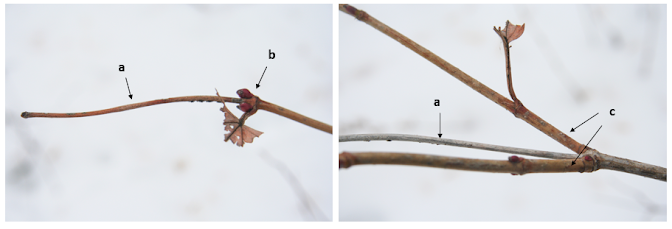This happens in some species when growing shoots don’t
harden off in fall. Instead, their stems die back, leaving the end-most lateral
buds to take over as the last buds on the twigs.
According to several keys, false terminal buds are found
only on woody plants with alternate lateral buds. The stems of plants with
opposite buds may also wither or die back before winter, but the end-most pair
of buds are not called false terminal buds.
This difference may seem trivial, but some winter keys use false and true terminal buds to separate species into groups or to confirm a plant’s identity. Fortunately, with a hand lens and some practice, there are reliable ways to recognize each.
True terminal buds
Consider a stem of a deciduous (leaf-shedding) tree or shrub
with alternate leaves along its length and a growing shoot at its tip. By
mid-summer, the plant begins forming buds in leaf axils, the angles between leaves
and stems. These are axillary or lateral buds, also called leaf buds.
When leaves are shed in fall, their petioles (leaf stalks) leave marks below
these buds, called leaf scars.
At the same time, growth stops at the tip of the stem and the young shoot is enclosed in either bud scales or protective leaves. This is a true terminal bud (c). It has no leaf scar (b) below it, and it is often larger than lateral buds (a).
 |
| I |
False terminal buds
Now consider a stem that, instead of forming a terminal bud,
dies back to the closest lateral bud. This is a false terminal bud. It has a leaf
scar below it and is about the same size as other lateral buds.
The stub of the withered stem may project above the base of the bud on the side opposite the leaf scar. The mark it leaves, called a branch scar (b), can be mistaken for a leaf scar, but it won’t have vascular bundle scars. This can be hard to see without a hand lens. Also, in some species with false terminal buds, the bud is noticeably angled toward or away from the twig (a).
 |
Examples
Black Walnut (Juglans nigra) is a tree with alternate buds (a) and heart-shaped or three-lobed leaf scars. The true terminal bud (b) is larger than the lateral buds and does not have a leaf scar. The last lateral bud (c) sits just below the terminal bud.
 |
American Elm (Ulmus americana), another tree with alternate buds, has false terminal buds. In the photos below, a branch scar is evident above the base of the bud (a) and a leaf scar (b) is on the opposite side, below the bud. Like some other species with false terminal buds, the bud is angled.
 |
Silver Maple (Acer saccharinum) is a tree with
opposite or paired lateral buds (a) and a true terminal bud (b) that is larger than the lateral buds and has no leaf scar (c). The last pair of buds (d) sits just below the terminal bud.
 |
Basswood (Tilia americana) is a tree with alternate lateral buds and false terminal buds. Below, the false terminal bud has a leaf scar (a) and is about the same size as the lateral bud below it. The branch scar (b) is smaller and darker than the leaf scar.
 |
Highbush Cranberry (Viburnum trilobum, V. opulus) is a shrub with opposite buds. It does not form terminal buds of any kind. Instead, in fall, the ends of the stems (a) wither back to the last pair of opposite buds (b), which will resume growth in spring. As this pattern repeats, the shrub branches in a Y-shaped form called sympodial growth (c).
 |
Some Winter ID Guides
The following guides can help with winter ID of trees and shrubs. When using any guide or key, look at several twigs and buds to see what’s typical. Variations are common.
The LEAF Program from UW-Stevens Point is a K-12 forestry education initiative that offers many online resources. Under Curriculum & Resources, choose LEAF Tree Identification Tools. The LEAF Winter Tree ID Key is available there as a downloadable PDF.
Pocket
Reference for Winter Tree Identification. Champaign County Forest Preserves, Mahomet, IL.
Fruit and Twig Key to
Trees and Shrubs, by William M. Harlow, PhD. Reprint edition, 1959. Dover
Publications, Inc., New York. ISBN 0-486-20511-8.




